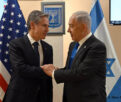Afghanistan: Flawed Peace Strategy*

 Kabul is hosting a three –day Peace Jirga (June 2-4) of about 1500 delegates from all over the country handpicked by the Karzai government to pump prime its plans for a much –desired Afghan reconciliation. It coincided with reports that Saudis and Iranians are bankrolling the Taliban groups operating from Waziristan. An estimated 920 million pounds poured in from Saudi private backers alone and all that money reached the targeted groups through Pakistani channels.
Kabul is hosting a three –day Peace Jirga (June 2-4) of about 1500 delegates from all over the country handpicked by the Karzai government to pump prime its plans for a much –desired Afghan reconciliation. It coincided with reports that Saudis and Iranians are bankrolling the Taliban groups operating from Waziristan. An estimated 920 million pounds poured in from Saudi private backers alone and all that money reached the targeted groups through Pakistani channels.
Expectedly, the West, particularly the United States, has thrown its weight behind the Peace Jirga.
First, the West is keen to secure the broadest possible endorsement of its plans for a turn around of the Afghan situation. The jirga will be followed by a Conference on economic development in July and parliamentary elections in September.
Second, such a conference helps to hide from public view the dilemma that has gripped the West, which wants to exit from Afghanistan as quickly as feasible, and as painlessly as possible.
Though the West is exposed to Afghan tribes for close to three decades, there appears a flaw in their understanding of the sturdy Afghans. It is obvious from the oft repeated rewards and privileges for militants who make a cross over to the government side. The peace plan drafted by President Karzai and his aides also lays stress on rewards. It is in synch with the White House thinking, which is keen on doing business with ‘good’ Taliban through a mixture of amnesty and attractive resettlement packages.
Reintegration projects will be initially implemented in Kandahar, Helmand, Badghis, Nangarhar, Kunduz, Baghlan and Herat provinces where the insurgents are believed to be more active.
Humanitarian and development aid is always welcome in a war ravaged economy but to expect the Afghan Peace and Reintegration Programme (APRP) to perform miracles is to miss the woods for the trees.
The Afghans and the tribals in Western Pakistan are motivated less by economic factors – living in deprivation is a part of their daily life; they love their weapon, their independence and their religion – though not necessarily in that order. They all have taken up arms as much to establish their fiefdoms as to usher in an Islamic Khilafat.
Another fundamental issue at play is the backing from elements in Pakistan army and intelligence establishment, who use them as pawns in their geo-political and strategic plans. Take the case of Taliban, presently unwanted in Waziristan. Many of them are crossing into the Barg-e-Matal district in Nuristan Province, which has few Afghan security troops and a small detachment of American troops.
Without addressing these fundamental issues reintegration will not work.
There is another potential flaw in APRP and the $1.5 billion fund proposed for its implementation.
As per the plans, the aid to the Taliban cadres for enticing them to come back will be threat based rather than needs-based system. So, the Taliban particularly cadres at the bottom of the insurgent pyramid will have an incentive to keep the war zone on the boil in perpetuity. New recruits may swell insurgent ranks with a view to grab the incentives on offer. Perverse incentive? Well, it is but perfectly possible.
The proposals before the peace jirga don’t address a major fault-line of the Afghan set up, namely rampant corruption and administrative inefficiency. It is because of this state of affairs that the Karzai government has failed to spread its wings and win over the people. And the UN-backed drive to stamp out illicit opium production failed to deliver results.
Unless these issues are addressed seriously and sincerely, the latest peace mission will be no different from the three previous peace meetings and the 2005 Peace and Reconciliation Commission.
Optimism can bring hope only when it is rooted in realism and is anchored in local conditions. Not money, amnesty, power-sharing or more fighting
(*This commentary first appeared on www.poreg.org)
-
Book Shelf
-
 Book Review
DESTINY OF A DYSFUNCTIONAL NUCLEAR STATE
Book Review
DESTINY OF A DYSFUNCTIONAL NUCLEAR STATE
- Book ReviewChina FO Presser Where is the fountainhead of jihad?
- Book ReviewNews Pak Syndrome bedevils Indo-Bangla ties
- Book Review Understanding Vedic Equality….: Book Review
- Book Review Buddhism Made Easy: Book Review
- Book ReviewNews Elegant Summary Of Krishnamurti’s teachings
- Book Review Review: Perspectives: The Timeless Way of Wisdom
- Book ReviewNews Rituals too a world of Rhythm
- Book Review Marx After Marxism
- Book Review John Updike’s Terrorist – a review
-
-
Recent Top Post
-
 NewsTop Story
What Would “Total Victory” Mean in Gaza?
NewsTop Story
What Would “Total Victory” Mean in Gaza?
-
 CommentariesTop Story
The Occupation of Territory in War
CommentariesTop Story
The Occupation of Territory in War
-
 CommentariesTop Story
Pakistan: Infighting in ruling elite intensifies following shock election result
CommentariesTop Story
Pakistan: Infighting in ruling elite intensifies following shock election result
-
 CommentariesTop Story
Proforma Polls in Pakistan Today
CommentariesTop Story
Proforma Polls in Pakistan Today
-
 CommentariesTop Story
Global South Dithering Away from BRI
CommentariesTop Story
Global South Dithering Away from BRI
-
 News
Meherabad beckons….
News
Meherabad beckons….
-
 CommentariesTop Story
Hong Kong court liquidates failed Chinese property giant
CommentariesTop Story
Hong Kong court liquidates failed Chinese property giant
-
 CommentariesTop Story
China’s stock market fall sounds alarm bells
CommentariesTop Story
China’s stock market fall sounds alarm bells
-
 Commentaries
Middle East: Opportunity for the US
Commentaries
Middle East: Opportunity for the US
-
 Commentaries
India – Maldives Relations Nosedive
Commentaries
India – Maldives Relations Nosedive
-
AdSense code



















